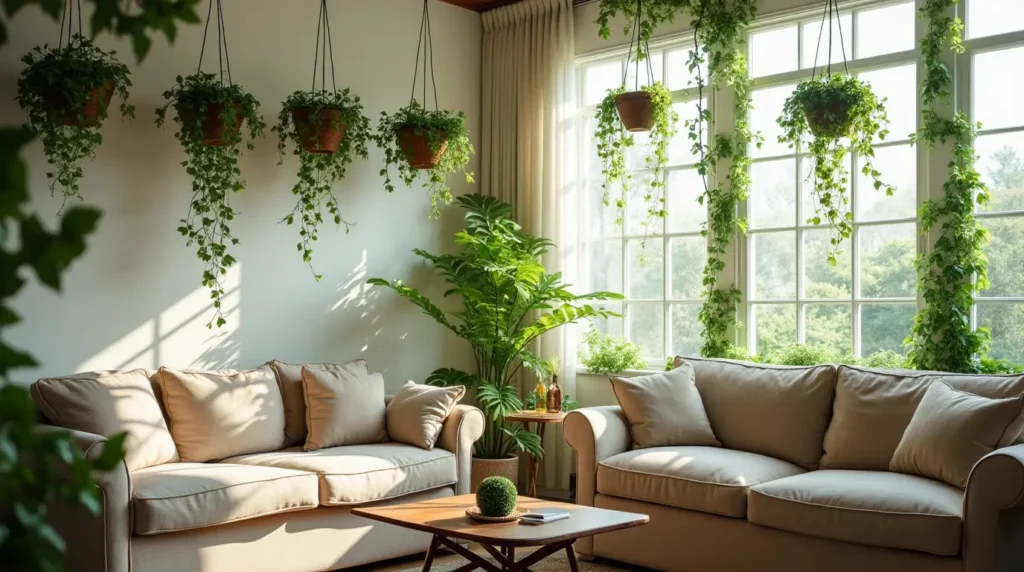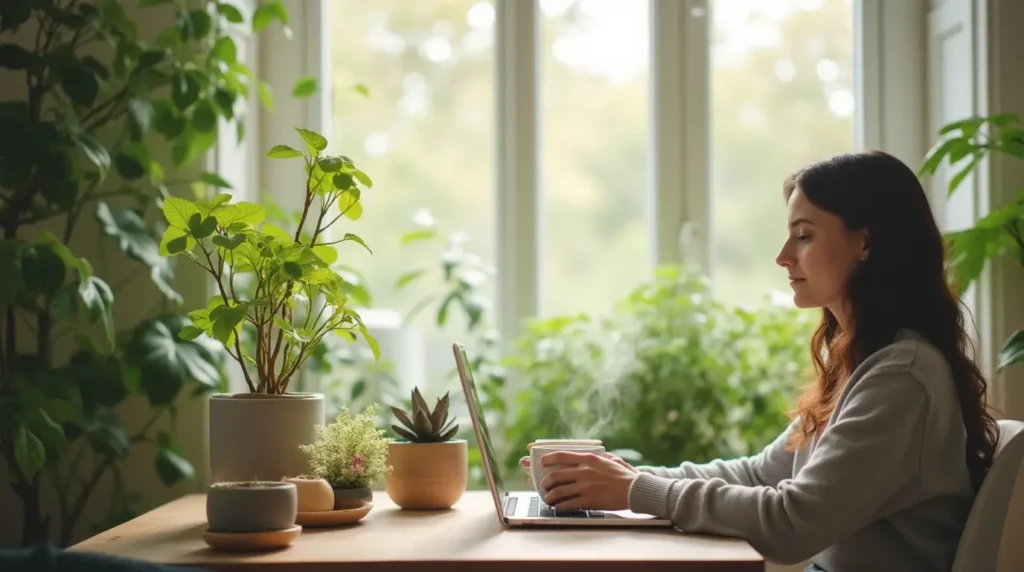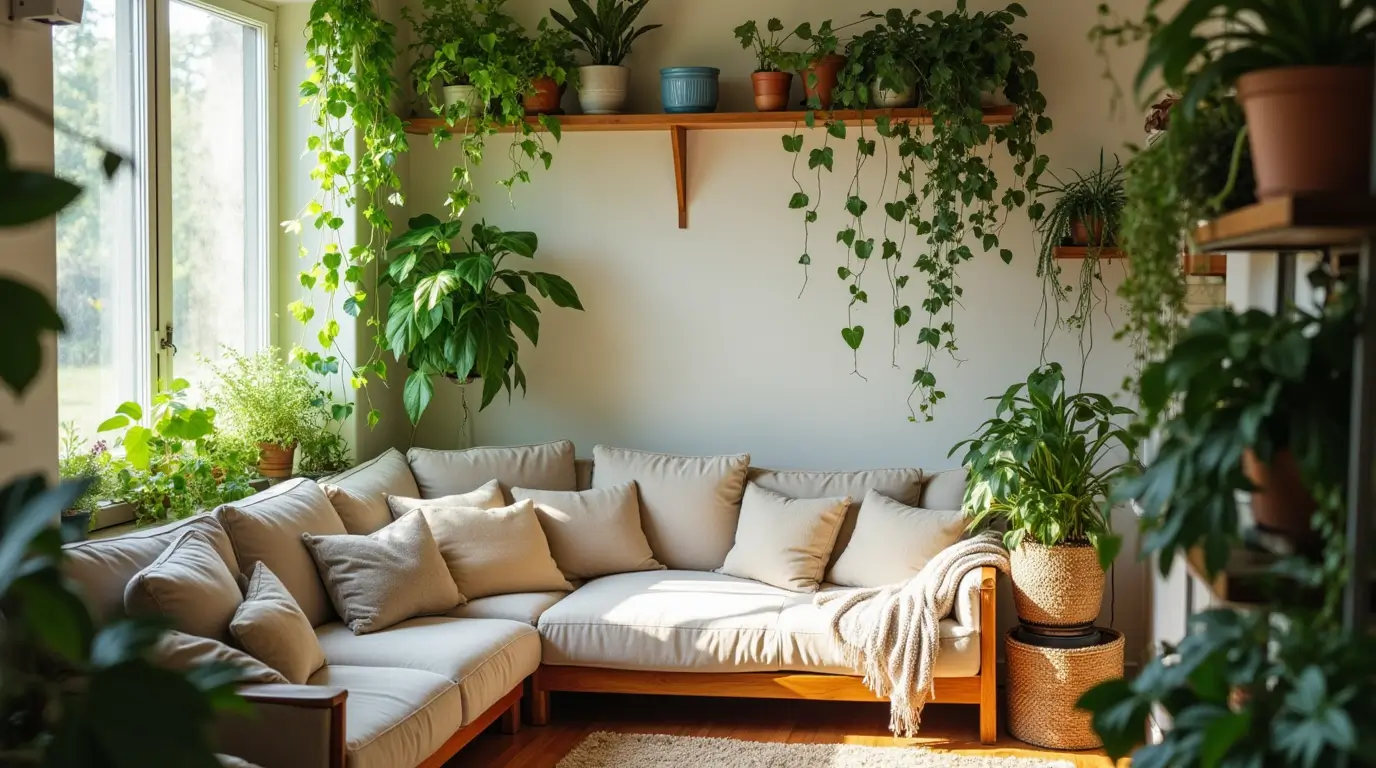Indoor Vine Plants: Create a Cozy, Inviting Ambiance Now.
Have you ever stepped into a room and felt an immediate sense of calm? Perhaps it was the soft glow of natural light or the inviting scent of a freshly brewed cup of tea, but if you looked around, you may have noticed the lush greenery that wrapped around the space like a warm embrace.
There’s something undeniably soothing about the presence of plants—especially indoor vine plants. These resilient climbers and trailers don’t just add beauty; they transform a space, creating a cozy, inviting ambiance that draws you in and makes you feel at home.
Indoor vine plants are more than just decorative pieces; they’re nature’s way of adding tranquility to your surroundings.
Whether you’re a plant enthusiast or someone who’s never considered a green touch for your home, you can instantly elevate your living space with the right vine plants.
Imagine the soothing presence of a lush pothos trailing down a bookshelf or the subtle elegance of ivy cascading from a hanging basket. It’s not just about aesthetics—it’s about creating an environment where you can breathe easy, unwind, and feel at peace.
So, if you’re wondering how you can make your home feel more welcoming, it’s time to explore how indoor vine plants can enhance your space.
Let’s dive into the wonderful world of these versatile, beautiful plants and discover the perfect options for your home!
Why Choose Indoor Vine Plants for Your Home?

Indoor vine plants are not only beautiful and versatile, but they also bring a range of benefits that make them a must-have for any home.
From improving air quality to saving space and enhancing décor, these plants offer more than meets the eye. Here’s why you should consider adding them to your indoor space.
Air Purification: Clean and Fresh Air for a Healthier Home
Did you know that indoor vine plants can help purify the air in your home? Certain plants, such as pothos, ivy, and philodendron, are known for their ability to remove toxins from the air, creating a cleaner and healthier living environment.
This is especially important in modern homes where indoor air quality can be compromised by pollutants like formaldehyde, benzene, and xylene.
According to NASA’s Clean Air Study, certain houseplants, including indoor vine plants, can absorb these harmful chemicals, reducing their concentration in the air. Plants like pothos and ivy work by absorbing these pollutants through their leaves, improving the overall air quality of your home.
With more time spent indoors, particularly in well-sealed homes, investing in indoor vine plants can help you breathe easier and enjoy a healthier living space.
Space Efficiency: Perfect for Small Spaces
Indoor vine plants are ideal for smaller homes or apartments where space is limited. Unlike traditional plants that require ample floor space, vines are naturally designed to climb and trail, which means they can thrive vertically.
By growing upward or cascading down from a hanging basket, indoor vine plants save floor space while still adding beauty and greenery to any room.
For those living in apartments or with smaller rooms, indoor vine plants can fill corners, create privacy screens, or even frame windows—helping you make the most of your space without crowding it.
You can even train these plants to grow on trellises or vertical plant stands, making them perfect for tiny spaces that need a touch of greenery without overwhelming the room.
Aesthetic Appeal: Adding Elegance to Any Style
Another reason to choose indoor vine plants is their versatility in complementing various interior styles. Whether your home is modern, bohemian, rustic, or even minimalist, indoor vine plants can seamlessly integrate into your décor.
Their natural beauty, coupled with their flexibility in growing shapes, makes them a perfect addition to any room.
For a cozy, boho-inspired space, hanging ivy from the ceiling or allowing pothos to cascade from a shelf can create a relaxed, lived-in feel.
In a more modern setting, a neatly trained philodendron climbing up a stylish trellis brings both sophistication and freshness.
These plants add life, color, and texture to any room, helping to soften the edges of contemporary furniture and adding warmth to more minimalist designs.
Supporting Data: The Proven Benefits of Indoor Vine Plants
The air-purifying benefits of indoor vine plants are not just anecdotal—they are backed by scientific research. As mentioned earlier, NASA’s Clean Air Study highlighted the ability of specific plants, including indoor vine plants like pothos and ivy, to remove harmful pollutants from the air.
Additionally, various studies show that having plants in your home can reduce stress levels, improve focus, and even increase productivity.
In fact, a study published in the Journal of Environmental Psychology found that the presence of indoor plants, particularly leafy vines, can positively affect your mood and well-being. By investing in indoor vine plants, you’re not just enhancing your décor—you’re also improving your overall quality of life.
Indoor vine plants aren’t just attractive accents in your home—they provide a range of benefits that improve both the health and aesthetic appeal of your living space.
Whether you’re looking to purify the air, make the most of limited space, or create a stylish environment, indoor vine plants can do it all. With their flexibility and beauty, they’re the perfect way to bring nature into your home.
Popular Indoor Vine Plants to Elevate Your Space

When it comes to enhancing your indoor space with plants, indoor vine plants are a go-to choice for creating a cozy, inviting atmosphere. With their ability to climb, trail, and cascade, these plants add dimension and beauty to any room.
Whether you’re new to plant care or an experienced green thumb, there are plenty of indoor vine plants to suit your needs. Here are some of the most popular vine plants that can elevate your space and make your home feel like a lush sanctuary.
Pothos: Low-Maintenance, Great for Beginners
If you’re new to indoor gardening, pothos (Epipremnum aureum) is the perfect plant to start with. Often called “devil’s ivy,” pothos is incredibly easy to care for and thrives in a variety of conditions. This resilient vine plant can grow in low to moderate light, making it an ideal choice for spots that don’t get a lot of direct sunlight.
The best part about pothos is its forgiving nature when it comes to watering. It can tolerate occasional neglect, making it great for busy individuals or plant novices. Just water it when the top of the soil feels dry to the touch, and you’ll see this vine flourish.
With its trailing green and variegated leaves, pothos is an elegant addition to any indoor space, whether placed on a shelf, hanging in a basket, or draping from a corner.
English Ivy: Ideal for Hanging Baskets or as a Climber
English ivy (Hedera helix) is a classic indoor vine plant that’s both visually striking and functional. Known for its ability to climb, English ivy can be trained to grow vertically or allowed to cascade from a hanging basket, adding a dynamic touch to your space.
Its dark green leaves with a slightly glossy finish create a timeless, elegant look that works well in traditional or modern interiors alike.
Ideal for rooms with bright, indirect sunlight, English ivy thrives when given a moderate amount of water—making it a low-maintenance option once established.
This indoor vine plant is also highly adaptable and can grow in a variety of conditions, from being draped over a trellis to flowing down from the edge of a shelf. If you’re looking to add some greenery to your home that’s easy to manage, English ivy is a solid choice.
Philodendron: Known for Heart-Shaped Leaves, Perfect for Creating a Cozy Atmosphere
Philodendrons are beloved for their heart-shaped leaves and their ability to create a warm, welcoming vibe.
These indoor vine plants are perfect for adding a cozy feel to any room. With species like the popular heartleaf philodendron (Philodendron hederaceum), this vine thrives in low to moderate light conditions, making it a great fit for those rooms that may not have the brightest windows.
Philodendrons also have moderate watering needs—allowing the soil to dry out between waterings is usually enough to keep this plant happy.
Their cascading vines and beautiful foliage can instantly transform any space into a tranquil retreat, whether placed on a bookshelf, hanging in a basket, or trailing from a decorative pot.
String of Pearls: Unique and Beautiful, Adds a Touch of Elegance to Any Room
If you’re looking for something a bit more unique, the String of Pearls (Senecio rowleyanus) is an indoor vine plant that stands out.
With its distinctive, bead-like leaves that resemble pearls, this plant adds a touch of elegance and charm to any indoor space. It thrives in bright, indirect light and requires infrequent watering, making it a relatively low-maintenance option.
The trailing vines of String of Pearls can be hung in a decorative pot or placed on a shelf where they can cascade gracefully.
Their unique look adds character to both contemporary and minimalist interiors, bringing a sense of sophistication without overwhelming the space. Whether you hang it in the living room or position it in a corner of the kitchen, the String of Pearls is sure to become a conversation piece.
Table of Popular Indoor Vine Plants
To help you compare and choose the perfect indoor vine plants for your home, here’s a quick reference table that outlines their light requirements, watering needs, and difficulty level:
| Plant Name | Light Requirements | Watering Needs | Difficulty Level |
|---|---|---|---|
| Pothos | Low to moderate | Infrequent | Easy |
| English Ivy | Bright indirect | Moderate | Medium |
| Philodendron | Low to moderate | Moderate | Easy |
| String of Pearls | Bright indirect | Infrequent | Medium |
These popular indoor vine plants are not only stunning to look at but are also easy to incorporate into your home’s design.
Whether you prefer low-maintenance options like pothos and philodendron or are looking for something more unique like the String of Pearls, there’s an indoor vine plant to suit every style and level of care.
By choosing the right vines for your space, you can easily elevate the overall ambiance, creating a cozy, welcoming atmosphere for yourself and your guests.
How to Care for Indoor Vine Plants
Caring for indoor vine plants requires some understanding of their specific needs, but once you get the hang of it, you’ll see just how easy and rewarding it can be.
Whether you’re growing pothos, philodendron, or ivy, each vine plant comes with its own set of care requirements. Let’s dive into the key aspects of maintaining healthy and thriving indoor vine plants.
Light: The Right Amount Makes All the Difference
Each type of indoor vine plant has its own light preferences, and understanding these can help your plants thrive. Most indoor vine plants prefer bright, indirect light, but there are some variations depending on the species.
- Pothos: Thrives in low to moderate light but will do well in brighter spots as long as it’s not in direct sunlight.
- English Ivy: Prefers bright, indirect light but can tolerate lower light conditions, though it may grow slower.
- Philodendron: Grows best in low to moderate light; too much direct sunlight can scorch its leaves.
- String of Pearls: Requires bright, indirect light and will thrive near a window where it gets plenty of natural light.
Be mindful of where you place your indoor vine plants—direct sunlight can burn delicate leaves, while too little light can stunt growth.
Watering: Avoid the Common Overwatering Pitfall
Overwatering is one of the most common mistakes people make when caring for indoor vine plants. These plants tend to prefer their soil to dry out a bit between waterings. Here are some guidelines to help you get the watering balance right:
- Watering Tip: Always check the soil before watering. For most indoor vine plants, you should wait until the top inch of the soil feels dry to the touch.
- Pothos and Philodendron: These are relatively forgiving plants, and they can tolerate a bit of neglect. However, be cautious not to let them dry out completely.
- English Ivy: Requires moderate watering, keeping the soil moist but not waterlogged.
- String of Pearls: Needs infrequent watering. Water thoroughly when the soil is dry to the touch, but avoid over-watering.
To avoid root rot, always ensure your plants have well-draining pots. Standing water is the enemy of healthy indoor vine plants!
Humidity: Keep Your Vines Happy with Proper Moisture Levels
Humidity can play a big role in how your indoor vine plants thrive. Tropical vines, in particular, tend to do better in more humid environments. Here’s how you can manage humidity for your plants:
- Humidity Tip: For vines like pothos and philodendron, misting the leaves or placing a humidity tray under the plant can help create a more humid microenvironment. Alternatively, you can use a small humidifier to raise the humidity level.
- String of Pearls: This plant is a bit more tolerant of lower humidity levels and doesn’t require extra moisture in the air.
Pay attention to the environment where you keep your indoor vine plants, especially during dry winter months when indoor air tends to be drier.
Pruning: Keep Your Vines Lush and Full
Regular pruning helps your indoor vine plants grow fuller and more robust, keeping them healthy and visually appealing. Here’s how you can maintain a beautiful vine:
- Pruning Tip: Trim long vines every few weeks to encourage new growth. For plants like pothos, cut back any leggy stems to promote a bushier appearance.
- Training Vines: If your vine plant is trailing or climbing, regularly train it by directing it along a trellis or vertical support to keep it neat and tidy.
Pruning also allows you to remove any dead or yellowing leaves, preventing disease and encouraging fresh, new growth.
Step-by-Step Care Guide for Indoor Vine Plants:
- Watering: Water when the top inch of soil is dry.
- Light: Place vines near windows with indirect light.
- Humidity: Consider misting or using a humidity tray for tropical plants.
- Pruning: Regularly trim long vines to promote growth.
Decorating with Indoor Vine Plants: Creating the Perfect Ambiance
Indoor vine plants are not just a way to improve air quality—they’re also fantastic for transforming your space into a cozy, inviting sanctuary.
Let’s look at some creative ways to decorate with indoor vine plants to enhance your home’s atmosphere.
Hanging Baskets: Add Vertical Greenery
Hanging baskets are one of the best ways to incorporate indoor vine plants into your décor. They add vertical greenery and make your space feel more dynamic and vibrant.
You can hang plants like pothos, ivy, or philodendron in decorative baskets and let them cascade down.
Hanging baskets are perfect for kitchens, living rooms, or entryways where space is at a premium. Plus, they create a lovely sense of movement as the vines gently sway in the air.
Climbing Up Trellises: Vertical Gardening for a Striking Look
If you want to add drama to your space, consider training your indoor vine plants to climb trellises. A tall, elegant vine climbing up a trellis can add a touch of sophistication to your décor, especially in corners or next to windows.
Vines like English ivy, pothos, and philodendron all respond well to trellises, creating a lush, vertical garden.
Trellises can be made from wood, metal, or even bamboo, depending on your aesthetic preferences. It’s a great way to add height and greenery to your room while making the most of your space.
Incorporating Vines into Shelving or Windowsills: Make the Most of Their Cascading Nature

Another easy way to style indoor vine plants is by placing them on shelves or windowsills. Let the vines trail over the edge, creating a cascading effect that brings life and movement to your space. You can place small pots of pothos, philodendron, or ivy on your shelves and allow their vines to grow and drape down.
This method is particularly effective in creating a soft, inviting atmosphere in living rooms or bathrooms. Plus, it’s an excellent way to make use of vertical space.
Common Mistakes to Avoid When Caring for Indoor Vine Plants
While caring for indoor vine plants is relatively easy, there are a few common mistakes you should avoid to keep your plants healthy and thriving.
Overwatering: A Frequent Issue, Leading to Root Rot
Overwatering is one of the most common mistakes plant owners make. Indoor vine plants like pothos and philodendron are quite tolerant of dry soil, but they can’t stand sitting in water. Always ensure that your pots have good drainage, and water your plants only when the top inch of soil is dry.
Too Much Sun: Some Vines Can’t Tolerate Direct Sunlight for Extended Periods
While many indoor vine plants love light, too much direct sunlight can cause their leaves to scorch. Make sure to place your plants in spots that receive bright, indirect light, especially if you’re growing vines like pothos or ivy.
Not Providing Enough Space: Vines Need Room to Grow
Indoor vine plants need plenty of space to grow, so avoid overcrowding them. Allow the vines to spread and climb freely to promote healthy growth. If your plants are too cramped, their growth may slow down or become leggy.
Quick Tips:
- Don’t Overcrowd: Leave space for your indoor vine plants to breathe and grow.
- Check Water Drainage: Ensure your pots have proper drainage to avoid standing water.
Benefits of Indoor Vine Plants Beyond the Aesthetic
Indoor vine plants offer more than just beauty—they also provide mental and physical health benefits that can improve your well-being.
Mental Health: Reduce Stress and Improve Mood
Research has shown that having plants in your home can have a positive effect on your mental health. Caring for indoor vine plants can reduce stress, improve mood, and even boost cognitive function.
The act of nurturing your plants and spending time with them can promote relaxation and help you feel more connected to nature.
Productivity: Increase Focus and Creativity
Some studies suggest that indoor plants can help boost productivity and focus. Having indoor vine plants in your home office or study area can enhance concentration and creativity, making them a perfect addition to your workspace.
Connection to Nature: Reconnect in an Urban Setting
In urban environments where access to nature may be limited, indoor vine plants provide a welcome escape.
They allow you to create your own little oasis, bringing the outdoors inside and helping you feel more connected to the natural world.
FAQs About Indoor Vine Plants
What are the easiest indoor vine plants for beginners?
If you’re new to caring for plants, indoor vine plants like pothos, philodendron, and ivy are excellent choices. These plants are easy to care for, adaptable, and offer striking visual appeal. Pothos, in particular, is a favorite among beginners due to its resilience and forgiving nature.
Whether you’re just starting out or looking for low-maintenance greenery, these vines will help you get started on the right foot.
How often should I water my indoor vine plants?
The general rule of thumb is to water your indoor vine plants when the top inch of soil feels dry. However, keep in mind that the watering schedule can vary based on the type of plant and the environment.
For example, pothos and philodendron are more forgiving and can tolerate slight dry spells, while others, like ivy, prefer to be watered more regularly. Always check the soil first and adjust based on the plant’s needs.
Do indoor vine plants need direct sunlight?
Many indoor vine plants prefer bright, indirect light but can tolerate some direct sunlight, depending on the species.
Plants like pothos and philodendron can thrive in areas with indirect light, while others, like ivy, can handle a bit of direct sunlight, although too much can cause their leaves to scorch.
Be sure to place your vine plants in a spot where they receive the right amount of light for optimal growth.
Can indoor vine plants grow in low light?
Yes, many indoor vine plants are well-suited to low-light environments. Pothos, philodendron, and ivy are great examples of vines that thrive in dimmer spaces, making them perfect for areas in your home that don’t receive much natural light.
While these vines may not grow as quickly in low light, they will still flourish, offering lush greenery without needing to be placed in bright spots.
Conclusion: Bringing Cozy Vines Into Your Home
Indoor vine plants are a wonderful way to elevate your home’s atmosphere by improving air quality, enhancing your décor, and bringing nature inside.
Whether you’re looking for a low-maintenance option like pothos or something with a bit more personality like ivy, indoor vine plants offer versatility and beauty that fit almost any style.
By choosing the right plants, placing them in ideal locations, and providing the necessary care, you can enjoy the calming, refreshing ambiance that only these vines can provide.

